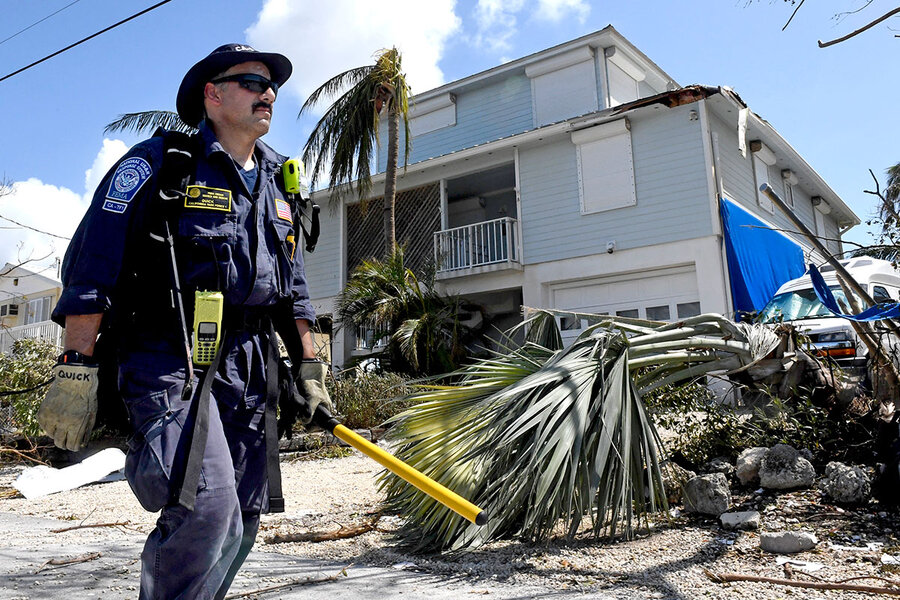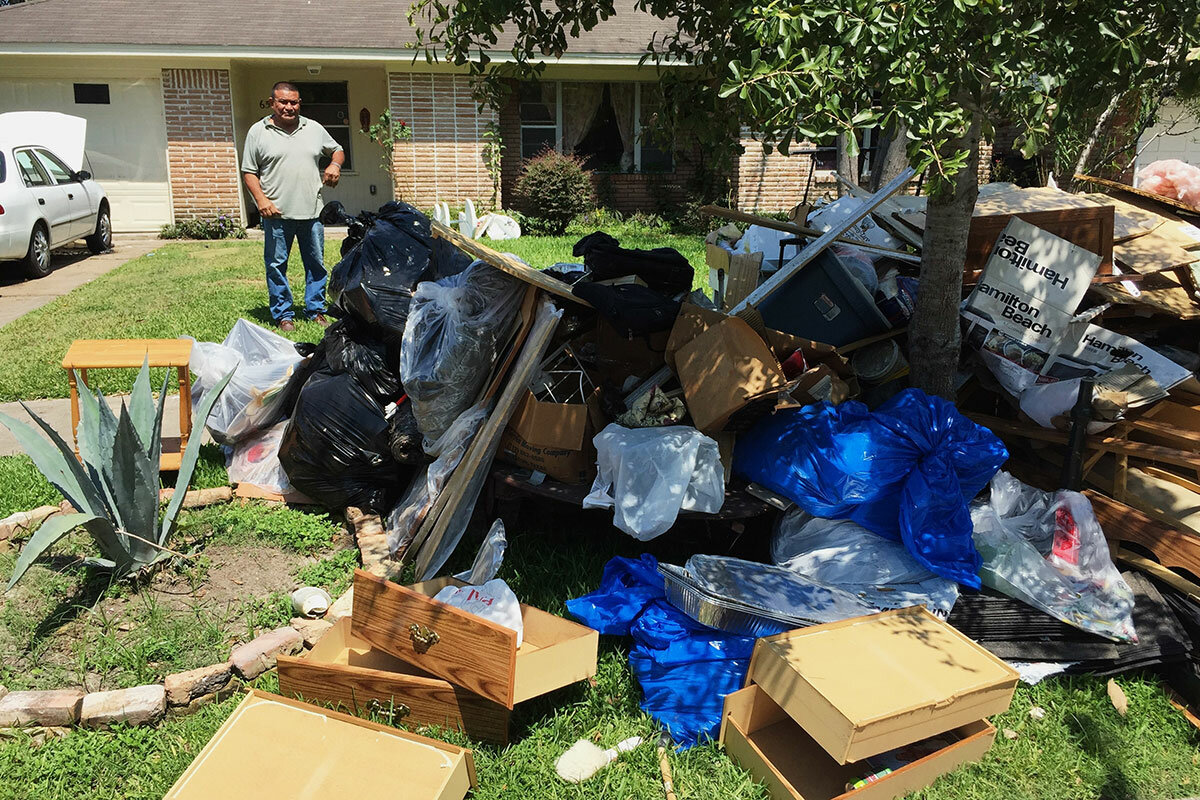With rebuilding under way, assessing government responses to Irma and Harvey
Loading...
The southeastern United States is struggling back onto its feet following this month’s battering from two huge storms. Thankfully, the human toll from hurricanes Harvey and Irma was not as great as feared. The Federal Emergency Management Agency (FEMA) and other government first responders have so far won plaudits for the speed and organization of initial aid deliveries.
But as can be said about the aftermath of so many important events, now the hard part begins. Rebuilding of some of the most damaged areas will take months, possibly years, as President Trump saw first-hand on Thursday during an inspection tour of Naples and other Florida cities. Lack of basic services creates continuing dangers, as the tragic, heat-related deaths at a Hollywood, Fla., nursing home showed.
America will face more of these crises as extreme weather appears to be on the increase and the built environment in harm’s way continues to expand. For FEMA, state and local responders, and planners the point is to learn from Harvey and Irma – as they learned from hurricane Katrina and superstorm Sandy – about better methods of prevention and revival.
“What we’re learning is that responding to disasters, as tragic as they are when they happen, is kind of the easy part,” says Gary Webb, professor and chair of emergency management and disaster science at the University of North Texas in Denton. “It’s that longer term recovery process . . . that’s the challenge we face locally and as a nation.”
So far at least 40,000 federal government personnel are directly involved in the response to this September’s one-two hurricane punch. Of those, about 2,600 are employees of FEMA, the fed’s main disaster response agency. As of Sept. 14, FEMA has provided states in the southeast with 6.6 million meals and 4.7 million liters of water, according to officials.
State and local responders provide the bulk of response manpower, however. In Harvey and Irma, semi-organized volunteer efforts such as the “Cajun Navy” have been a significant presence as well. That’s one of the new developments that helped make the overall response effective so far, says Dr. Webb.
“That’s a major shift in emergency management in this country. It’s more inclusive. They’re not just tolerating the presence of volunteers,” he says.
On the ground this can make a world of difference. Take the experience of Gail Elder and her friend Kathy Martin, evacuees from Tampa. Last week they pulled into an Alabama fairground with two dogs and little else. They figured they’d be sleeping in a car.
Wrong. A volunteer from a local church, Grandview Baptist, immediately came over to see how they were doing. Soon they had a brand-new tent, air mattress, and sleeping bags.
“Keep it or give it back, whatever you need to do,” the volunteer told them.
The response to the hurricanes has also been boosted in part by increased coordination among government entities themselves. Years of Department of Homeland Security exercises have strengthened links between federal agencies and local police departments.
FEMA – which constitutes about 22 percent of the Department of Homeland Security budget – is the face of Washington’s involvement in the recovery. The agency is opening offices throughout the affected area to provide temporary housing and rebuilding funds. In the wake of the storms Congress quickly passed a bill providing $15 billion for such efforts.
“I would give them credit for speed of action through both storms,” says Amy Liu, vice president and director of the Metropolitan Policy Program at the Brookings Institution, referring to the overall federal response.
But much more will be needed. In terms of cash, the $15 billion might run out in a month. Total federal recovery costs could be $100 billion or higher.
“It is to be determined how quickly the second round of money will be provided, particularly in response to Irma,” says Ms. Liu.
Following the disaster of hurricane Katrina in 2005, the ability of agencies to coordinate on the dissemination of aid, and plans for transitioning to longer term recovery roles, are now much clearer, according to Liu. But the need to move quickly stretches beyond FEMA. The Department of Housing and Urban Development is an essential part of housing assistance and infrastructure redevelopment. The Department of Labor needs to step up to provide to provide quick flexible funds to pay to train local workers to fill huge gaps in the workforce doing debris removal and home repairs. With 100,000 damaged homes in Texas alone, there’s going to be a lot of opportunity for anyone in the area who wants to work to do so.
The longer it takes for a family to return to their home, the longer it is until breadwinners go back to work and the local economy begins to recover.
“There are a lot of benchmarks to look for. When you are a family in an affected area, every day counts. Lack of attention, lack of aid, is felt day by day,” says Liu.
One difficult area where government may have performed well in the Harvey and Irma crisis was in evacuations. An improvement in the understanding of when and where to tell residents to flee may be one reason the death toll was not higher than it was.
“We are getting better with hurricane evacuations. I would say our ability to use traffic and management and operations is much, much better than it was 20 years ago,” says Brian Wolshon, a professor of transportation engineering and an evacuation expert at Louisiana State University.
Evacuation decisions are made with incomplete information under extreme time pressure and with life-or-death consequences, points out Dr. Wolshon. In Houston, for instance, there was no evacuation order, and people hunkered down. That decision is up for debate, Wolshon says, but it’s worth pointing out that evacuation itself is dangerous. The last major evacuation of Houston resulted in more than 100 deaths. So far, the recorded death toll from hurricane Harvey is 70 people.
What the extreme flooding in Texas may indicate is that experts might work more on identifying areas of extreme vulnerability. That is a forecasting problem, Wolshon says: identifying what areas will flood to what point given assumed rainfall.
That’s a specificity emergency agencies can’t yet provide. But individuals can make that decision on their own, Wolshon adds. Evacuation is really a personal choice.
“If you know your area is a flood danger and you hear forecasts of lots of rain ... you don’t have to wait for an order,” he says.
Staff writer Patrik Jonsson contributed to this report.










